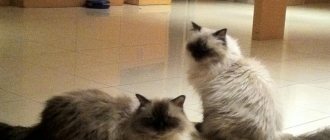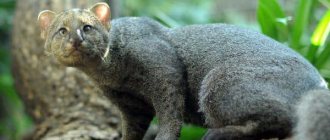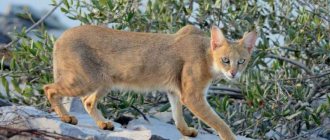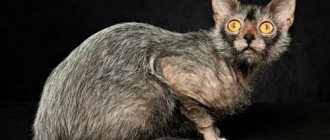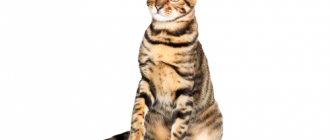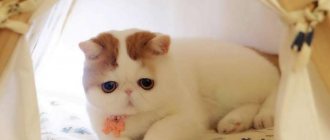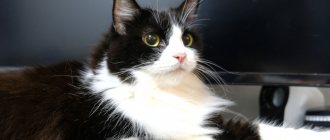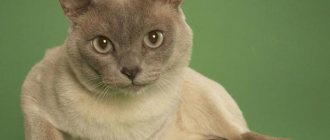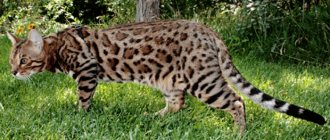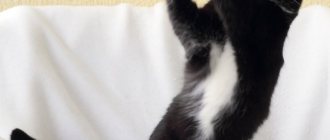The Bambino cat breed is native to Arkansas, USA. This cat breed was created by crossing the Munchkin and the Canadian Sphynx. As a result, Bambino cats received short legs from the Munchkin and a complete lack of hair from the Canadian Sphynx. No special work was carried out to create this breed of cats; we can say that the new breed appeared by chance, thanks to the married couple Pat and Stephanie Osborne, whose attention was attracted by a small, touching kitten with an unusual funny appearance, born from a munchkin and a Canadian Sphynx. It was Pat Osborne who gave the name to this cat breed. Being of Italian origin, he named the small charming kitten bambino, which translated from Italian means baby, baby, child. This breed name suits these cats perfectly, because they have adorable little faces that resemble the slightly wrinkled cute face of a baby. The breed appeared in Russia in 2005 and immediately attracted everyone's attention and interest. DescriptionCharacterCareNutrition
Description of the breed
According to TICA standards, Bambino cats have two main characteristics - short, strong legs and lack of hair. Bambinos have a muscular body and a large chest, which, combined with a rounded belly, give the cat the appearance of a robust animal. The cats themselves are small or medium in size, weight varies from 2 to 4 kilograms, males are usually larger than females. On a medium-sized head with rounded contours there are large, wide at the base and especially eye-catching ears. As a rule, bambinos have no hairs on the inside of their ears, although the standards allow small hairs on the back surface and on the outer lower edges of the ears. It is impossible not to pay attention to the large, almond-shaped, wide-set eyes that look so beautiful on the rounded faces of these extraordinary cats. A strong appearance is given to this cat by a well-developed lower jaw and a muscular neck of medium length. The Bambano's oval paws also have well-developed muscles and differ from other cats in having larger pads. The front legs may be shorter and thinner than the hind legs, which is allowed by the standards. The bambino's back is straight, but can be curved upward at the hind legs, which is not welcomed by experts. The tail is elastic and should be proportional in size to the slightly elongated body of the bambino. A characteristic feature of the tail is the presence of a hair brush, like the noble wild cats of the Savannah. The bambino's skin is covered with soft folds, very pleasant to the touch. The number of folds on the skin gradually decreases as the cat grows older. If you want to receive a dose of joy, positivity and energy every day, get a bambino, he will color your life with his cheerful and restless disposition.
Price and where to buy a bambino kitten
The cost of a bambino kitten is high. Although the breed still has experimental status, it is divided into classes.
Pet-class kittens are the cheapest. They are sold already sterilized and will not take part in breeding. The defects are minor and an inexperienced person may not notice them. This will be a great housemate.
global $ads_google; //data-ad-slot=”2475549904″ $ads_google = empty($ads_google) ? false : true; ?> if ($ads_google == false) {?>
$ads_google = true; ?> } ?>
If you want to go to exhibitions, buy a show-class baby. And to breed the Bambino breed, you need to buy a Creed-class cat.
There are nurseries in Russia where you can buy a bambino kitten at a price of 45,000-60,000 rubles
.
The animal must be completely healthy at the time of the transaction, treated for parasites and already vaccinated according to schedule. Breeders share information about living conditions and medical research. All information will be reflected in the cat metric.
How to name kittens
Everyone knows the difficulties of coming up with names. It also happens that a name was invented, agreed upon by all household members, but when you look at the cat it seems that it’s not right, something else is needed.
A bambino boy or girl can be called a nickname with an Italian sound. Why not, the first owner named the breed in Italian?
We are sharing a list of beautiful names for the hairless, short-eared short-legged one!
Nickname table
| Girl | Boy | ||
| Tella Gata Marie Amanda Vixey Sigma Fiona Cameli Brada Emily | Elina Greya Lulya Nyama Mouse Drop Daria Sandra Nigma Plusha | Velvet Zephyr Taisan Schwartz Valli Smiley Icek Altair Love Lenin | Felix Mikey Uchar Prime Shek Anteo Weiss Dodger Aylan Largo |
Character
By nature, these cats are as soft as their extraordinary velvet skin. Large, curious eyes, pricked ears, and a small nose can touch anyone who is interested in this breed of cat. And their cheerful disposition, playfulness and temperament will cheer up even the saddest person. These cats will find a common language with any inhabitant of your home; they quickly adapt to new people, different animals, and a change of environment. They are very active and love to travel, and can handle road trips very well. Another touching feature of bambino cats is their ability to sit for a long time in the rabbit position, with their paws folded on their chest.
Castration and sterilization
If the owners do not have a goal to breed bambino, then it is better to artificially stop the animal’s reproductive functionality. The procedure for removing the sex glands (testes in cats and ovaries in cats) is carried out according to a standard procedure. Recovery after surgery is easy. Castrated and sterilized bambinos do not cease to be cheerful and active, and there is no tendency to obesity with proper nutrition.
At what age is it recommended to have surgery?
The earliest age at which a bambino can be castrated is six months. Before this period, surgery is prohibited, since the full development of the internal organs is not complete, the testes are “hidden” in the abdominal cavity or in the area of the inguinal ring. Cats need to be sterilized even later - starting at eight months of age.
Caring for your pet after surgery
If the castration or sterilization procedure went without complications, then the rehabilitation period will not take more than a month. Immediately after the operation, the animal should be placed in a warm place, wrapped in a blanket. Do not leave the animal near the radiator or in direct sunlight - bare skin can quickly burn.
Hairless cats have no hair and get cold quickly. If the animal is trembling, it should be wrapped in a blanket
It is important to ensure complete rest for the operated bambino. The animal should not be nervous; it will try to jump on its paws and run away to hide. Such activity may cause the seams to come apart.
It is important to monitor the condition of the postoperative wound for two weeks. Sutures must always remain dry and clean, not fester, not become inflamed, and not bleed. To prevent infection, the sore spot is treated with antiseptic agents (dioxidine, chlorhexidine, hydrogen peroxide). Every day the animal should get better - appetite and good mood should return. If this does not happen, you should contact your veterinarian so that he can conduct a thorough examination of the cat.
Nutrition
The lack of hair also affects the eating behavior of cats of this breed; their metabolism is accelerated, so these cats eat more than other breeds.
Food for them should be high-calorie, so as not to get confused in calculating the calorie content of food for this breed of cat, it is best to use ready-made premium and super-premium class food, which is specially designed for such cats, as food. This will keep them healthy and ensure that all the necessary vitamins and nutrients enter the animal’s body. Return to list
The history of the bambino
The breed of these cats originated in 2005 in Arkansas due to an accidental mating of a Sphynx and a Munchkin. The owners did not like the kitten that was born, and they sent it to a cat shelter.
The unusual animal was seen by the spouses Stephanie and Pete Osborne. They were fascinated by the unusual appearance: short legs, bald skin, huge ears and very expressive eyes of the cat won the hearts of the couple. Since Miss Osborne is Italian, she decided to name the kitten Bambino, which translates from Italian as “baby, baby.” The nickname suited the animal perfectly because of its mischievous disposition and touching appearance, so subsequently the entire breed began to be called bambino.
At the end of 2005, the Osborne couple approached the prestigious American cattery HolyMoly with an offer to breed their unusual cat. Over the course of a year, experts conducted research on the condition and viability of these miniature hairless cats. The cattery sent applications to two prestigious international cat associations TICA and REFR for recognition of the bambino. In November 2006, TICA added the bambino to the experimental group (meaning that in order to be recognized as a new breed, the stability of the hereditary characteristics must be proven by breeding several more generations of bambino). But the Rare and Exotic Feline Registry Association recognized the bambino and included it in the Register of Rare and Exotic Animals in 2006.
It is important to note that there were cases of crossing sphinxes and munchkins even before the first bambino was born in 2005. But previously, from such a relationship, kittens were born with an incomplete absence of hair. Soft hairs 2–5 mm long can be seen on their face, ears, paws, tail and under the tail; Sometimes fur is present along the entire length of the paws, on the hips and shoulders. These cats are classified as Minskins. In addition to partial hairiness, they have one more difference from bambino - the presence of whiskers (bambino always lacks “whiskers”).
The main difference between a manskin and a bambino is that they may have fur on their face, paws, tail, back, chest and shoulders. Minskins only have to be bald on the stomach
Cat breeds
Did you think you knew everything about cat breeds? Test your knowledge on the official website of German natural pet food Bosch. We present an extensive catalog of various cat breeds. The section contains more than 70 reference articles. The names of cat breeds with detailed descriptions and high-quality photos will be of interest to both experienced cat lovers and those who are just thinking about buying an animal.
If you do not want to search alphabetically, write the desired cat breed and use the search bar. Each description of cats with photographs is divided into several parts: a brief information about the breeding of the breed, then a detailed description of the physiological characteristics - for example, the shape of the head, ears and eyes, the size of the body, the nature of the color, the length of the coat, etc.
Descriptions, photographs and character
For future owners of graceful creatures, the section on the character of various breeds of cats and kittens will be extremely useful. Here you can find out how your pet tends to communicate with people - affectionate and trusting or emphatically independent and even sometimes aggressive? Or perhaps kittens are future excellent hunters, playful and curious, which means it will be impossible to lock the warlike tailed one within four walls. A detailed description of the breed will help you make the right choice. We especially note that the catalog contains expensive and rare cat breeds.
Often the determining factor when choosing a pet is its appearance. Especially if you entrust the choice of a pet to children. But when looking at photos of cat breeds, do not forget that only a careful acquaintance with the description of the character can serve as a guarantee that in the future there will be no disagreements between you and a tailed family member.
Table: pros and cons of the breed
| Characteristic | Plus | Minus |
| Activity | The cat is cheerful and active. | He will constantly demand attention, ask to be played with. |
| Friendliness | This is a peaceful breed of cats that rarely shows aggression (prefers not to fight, but to hide). | They cannot stand up for themselves, so they need special human care. |
| Health | With proper care there will be no health problems. | A person will have to constantly ensure that the cat is warm, but does not receive burns from radiators and the sun. |
| Nutrition | Unpretentious in food. | Bambinos have a good metabolism, so they need high-calorie food. |
| Care | In general, the care procedures are simple. | Cats will have to be bathed frequently with special shampoos and their skin cleansed with lotions every day. |
| Uniqueness | This is a new breed, with interesting external features. | The uniqueness of the bambino is reflected in their price. On average, you will have to pay about 150–200 thousand rubles for one kitten. |
